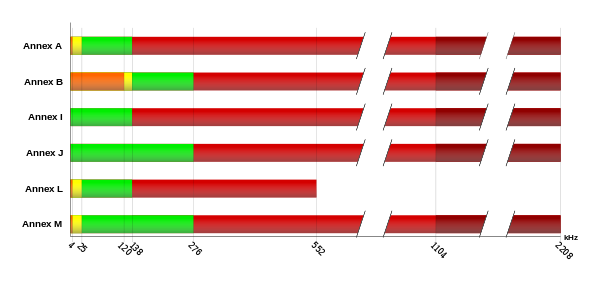G.992.5 Annex M
 | |
| Status | In force |
|---|---|
| Latest version | 1.2 April 2004 |
| Organization | ITU-T |
| Related standards | G.992.5 |
| Domain | telecommunications |
| License | Freely available |
| Website | https://www.itu.int/rec/T-REC-G.992.5/ |
Annex M is an optional specification in ITU-T recommendations G.992.3 (ADSL2) and G.992.5 (ADSL2+), also referred to as ADSL2 M and ADSL2+ M. This specification extends the capability of commonly deployed Annex A by more than doubling the number of upstream bits. The data rates can be as high as 12 or 24 Mbit/s downstream and 3 Mbit/s upstream depending on the distance from the DSLAM to the customer's premises.[1][2]

Legend Upstream Downstream ADSL/ADSL2 Additional Downstream ADSL2+ |
The main difference between this specification and Annex A is that the upstream/downstream frequency split has been shifted from 138 kHz up to 276 kHz (as in Annex B/Annex J), allowing upstream bandwidth to be increased from 1.4 Mbit/s to 3.3 Mbit/s, with a corresponding decrease in download bandwidth.
Deployment
This standard was approved for deployment on Australian networks by the Australian Communications Industry Forum (ACIF).
See also
External links
- ITU-T Recommendation G.992.3 : Asymmetric digital subscriber line transceivers 2 (ADSL2)
- ITU-T Recommendation G.992.5: Asymmetric Digital SubscriberLine (ADSL) transceivers - Extended bandwidth ADSL2 (ADSL2+)
- ITU-T Recommendations: Series G
- ITU-T
- Internode ADSL2+ Annex M FAQ
- White Paper on Annex M
References
- ^ "G.992.3: Asymmetric digital subscriber line transceivers 2 (ADSL2)". www.itu.int. Archived from the original on 2021-06-13. Retrieved 2021-06-13.
- ^ "G.992.5: Asymmetric digital subscriber line 2 transceivers (ADSL2)- Extended bandwidth ADSL2 (ADSL2plus)". www.itu.int. Archived from the original on 2021-06-13. Retrieved 2021-06-13.
